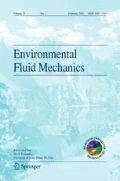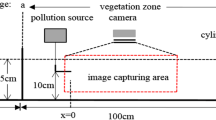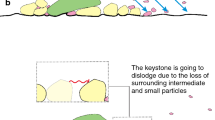Abstract
Submerged aquatic vegetation has the potential to greatly improve water quality through the removal of nutrients, particulates and trace metals. The efficiency of this removal depends heavily upon the rate of vertical mixing, which dictates the timescale over which these constituents remain in the canopy. Continuous dye injection experiments were conducted in a flume with model vegetation to characterize vertical mass transport in vegetated shear flows. Through the absorbance–concentration relationship of the Beer–Lambert Law, digital imaging was used to provide high-resolution concentration profiles of the dye plumes. Vertical mass transport is dominated by the coherent vortices of the vegetated shear layers. This is highlighted by the strong periodicity of the transport and its simple characterization based on properties of the shear layer. For example, the vertical turbulent diffusivity is directly proportional to the shear and thickness of the layer. The turbulent diffusivity depends upon the size of the plume, such that the rate of plume growth is lower near the source. In the far-field, mass is mixed more than twice as rapidly as momentum. Finally, plume size is dictated predominantly by X, a dimensionless distance that scales upon the number of vortex rotations experienced by the plume.
Similar content being viewed by others
References
G.J. Edgar (1990) ArticleTitleThe influence of plant structure on the species richness, biomass and secondary production of macrofaunal assemblages associated with Western Australian seagrass beds J. Exp. Mar. Biol. Ecol. 137 215–240
R.H. Kadlec R.L. Knight (1996) Treatment Wetlands Lewis Publishers Boca Raton, FL
N. Silvan H. Vasander J. Laine (2004) ArticleTitleVegetation is the main factor in nutrient retention in a constructed wetland buffer Plant Soil. 258 179–187 Occurrence Handle10.1023/B:PLSO.0000016549.70555.9d Occurrence Handle1:CAS:528:DC%2BD2cXjvF2qsLs%3D
J.D. Ackerman (2002) ArticleTitleDiffusivity in a marine macrophyte canopy: implications for submarine pollination and dispersal Am. J. Bot. 89 IssueID7 1119–1127
J. Finnigan (2000) ArticleTitleTurbulence in plant canopies, Annu Rev. Fluid Mech. 32 IssueID1 519–571
S. Ikeda M. Kanazawa (1996) ArticleTitleThree-dimensional organized vortices above flexible water plants J. Hydraul. Eng. 122 IssueID11 634–640
M. Raupach J. Finnigan Y. Brunet (1996) ArticleTitleCoherent eddies and turbulence in vegetation canopies: the mixing-layer analogy Bound.-Layer Meteorol. 78 351–382 Occurrence Handle10.1007/BF00120941
W. Gao R. Shaw K. Paw U. (1989) ArticleTitleObservation of organized structure in turbulent flow within and above a forest canopy Bound.-Layer Meteorol. 47 349–377 Occurrence Handle10.1007/BF00122339
M. Ghisalberti H. Nepf (2002) ArticleTitleMixing layers and coherent structures in vegetated aquatic flows J. Geophys. Res. 107 IssueIDC2 3-1–3-11 Occurrence Handle10.1029/2001JC000871
Ghisalberti M., Nepf H. (2004). The limited growth of vegetated shear layers. Water. Resour. Res.40. W07502, doi:10.1029/2003WR002776.
H. Nepf E. Vivoni (2000) ArticleTitleFlow structure in depth-limited, vegetated flow J. Geophys. Res. 105 IssueIDC12 28547–28557 Occurrence Handle10.1029/2000JC900145
H. Nepf J. Sullivan R. Zavistoski (1997) ArticleTitleA model for diffusion within emergent vegetation Limnol. Oceanogr. 42 IssueID8 1735–1745
M. Chandler P. Colarusso R. Buschsbaum (1996) A study of eelgrass beds in Boston Harbor and northern Massachusetts bays U.S. Environ. Prot. Agency Narragansett, RI
C. Dunn F. Lopez M. Garcia (1996) Mean flow and turbulence in a laboratory channel with simulated vegetation Dept. of Civil Engineering University of Illinois at Urbana-Champaign Urbana, IL
D. Poggi A. Porporato L. Ridol J. Albertson G. Katul (2004) ArticleTitleThe effect of vegetation density on canopy sub-layer turbulence Bound.-Layer Meteorol. 111 565–587
R.A. Schincariol E.E. Herderick F.W. Schwartz (1993) ArticleTitleOn the application of image analysis to determine concentration distributions in laboratory experiments J. Contam. Hydrol. 12 197–215 Occurrence Handle1:CAS:528:DyaK3sXktleqtrw%3D
C.M. Gramling Harvey C.F. L.C. Meigs (2002) ArticleTitleReactive transport in porous media: a comparison of model prediction with laboratory visualization Environ. Sci. Technol. 36 2508–2514 Occurrence Handle10.1021/es0157144 Occurrence Handle1:CAS:528:DC%2BD38XjtlOgsr8%3D
T. Bentham R. Britter (2003) ArticleTitleSpatially averaged flow within obstacle arrays Atmos. Environ. 37 2037–2043 Occurrence Handle10.1016/S1352-2310(03)00123-7 Occurrence Handle1:CAS:528:DC%2BD3sXis1Cltr8%3D
S. Corrsin (1974) ArticleTitleLimitations of gradient transport models in random walks and in turbulence Adv. Geophys. 18 25–60
Launder B. (1976). Topics in Applied Physics, Vol. 12, Chapt. 6. Heat and Mass Transport, pp. 231–287. Springer-Verlag.
S. Hassid (1983) ArticleTitleTurbulent Schmidt number for diffusion models in the neutral boundary layer Atmos. Environ. 17 IssueID3 523–527
K. Koeltzsch (2000) ArticleTitleThe height dependence of the turbulent Schmidt number within the boundary layer Atmos. Environ. 34 1147–1151 Occurrence Handle10.1016/S1352-2310(99)00369-6 Occurrence Handle1:CAS:528:DC%2BD3cXhs1Wqurw%3D
L. Fitzmaurice R.H. Shaw K.T. Paw U E.G. Patton (2004) ArticleTitleThree-dimensional scalar microfront systems in a large-eddy simulation of vegetation canopy flow Bound.-Layer Meteorol. 112 107–127 Occurrence Handle10.1023/B:BOUN.0000020159.98239.4a
A. Okubo (1971) ArticleTitleOcean diffusion diagrams Deep-Sea Res. 18 789–802
G.A. Lawrence K.I. Ashley N. Yonemitsu J.R. Ellis (1995) ArticleTitleNatural dispersion in a small lake Limnol. Oceanogr. 40 IssueID8 1519–1526
Weitbrecht V., Uijttewaal W., Jirka G.H. (2004). 2-D Particle tracking to determine transport characteristics in rivers with dead zones, In: Shallow Flows, G.H. Jirka and W.S.J. Uijttewaal (eds.), pp. 477–484, A.A. Balkema.
H. Nepf E. Koch (1999) ArticleTitleVertical secondary flows in submersed plant-like arrays Limnol. Oceanogr. 44 IssueID4 1072–1080 Occurrence Handle1:CAS:528:DyaK1MXktF2qurc%3D
Author information
Authors and Affiliations
Corresponding author
Rights and permissions
About this article
Cite this article
Ghisalberti, M., Nepf, H. Mass Transport in Vegetated Shear Flows. Environ Fluid Mech 5, 527–551 (2005). https://doi.org/10.1007/s10652-005-0419-1
Received:
Accepted:
Published:
Issue Date:
DOI: https://doi.org/10.1007/s10652-005-0419-1




